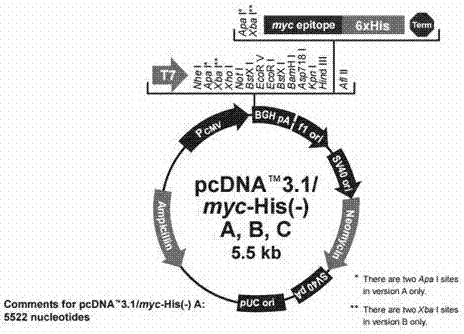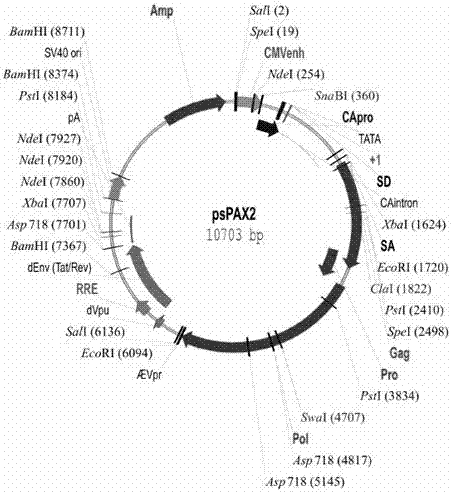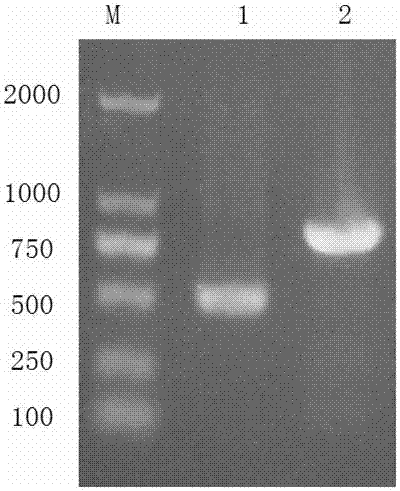Fusion gene betaTrCP-CypA with HIV-1 inhibition effect and construction method thereof
A technology of fusion gene and construction method, applied in gene therapy, fusion polypeptide, chemical instruments and methods, etc., can solve problems such as inability to clear viruses, virus rebound, etc.
- Summary
- Abstract
- Description
- Claims
- Application Information
AI Technical Summary
Problems solved by technology
Method used
Image
Examples
experiment example 1
[0041] Construction of pcDNA3.1his / betaTrCP-CypA According to the N-terminal sequence of human betaTrCP gene (GenBank accession number: NM_003939), the N-terminal sequence of betaTrCP gene was optimized by using DNASTAR and others. After optimization, Shanghai Sangon Bioengineering Co., Ltd. was commissioned to synthesize, and Premier5.0 software was used to design primers, and B1 and B2 were used as primers to amplify the part of the betaTrCPN end, and PrimeSTAR HS DNA polymerase was added to a 50 µl system. Amplification conditions are: pre-denaturation at 98°C for 15s, then 98°C for 10s, 58°C for 15s, and 72°C for 60s, 28 cycles, use CypAcDNA plasmid as template, use B3 and B4 as primers to amplify CypA part, add PrimeSTAR HS DNA polymerase enzyme to 50µl system. Amplification conditions are: pre-denaturation at 98°C for 15s, then 98°C for 10s, 58°C for 15s, and 72°C for 30s, 28 cycles. As a result, the target bands were amplified, and the sizes were about 800bp and 500bp r...
experiment example 2
[0044] Western blot detection of expression of betaTrCP-CypA, CypA recombinant protein
[0045] 293T cells were cultured, and the day before transfection, 293T cells were mixed with 1×10 6 The density of cells / well was cultured in 6-well plates. Day 2, with Entranster TM -D4000 Transfection Reagent Transfer 2 µg of pcDNA3.1his / betaTrCP-CypA and pcDNA3.1his / CypA (ratio 3:1) into each well respectively, and transfect 293T cells with pcDNA3.1his empty vector as a control. The fresh medium was replaced on the second day after transfection, and the cells were collected 48 hours later to extract the total protein of the cells. The BCA protein concentration assay kit was used for protein quantification and then detected by Western blot. After the protein was subjected to 12% SDS-PAGE, it was transferred to PVDF membrane, and after blocking, his-tag monoclonal antibody (pcDNA3.1his / betaTrCP-CypA and pcDNA3.1hisCypA with His tag) were added for incubation, and HRP-labeled goat anti...
experiment example 3
[0047] Degradation analysis of HIV-1Gag by betaTrCP-CypA 293T cells were inoculated into six-well plates one day before transfection, and plasmid pSPA X 2 Co-transfection with pcDNA3.1his / betaTrCP-CypA and plasmid pcDNA3.1his. Refer toEntranster TM -D4000 Transfection Reagent instructions. The experiment was divided into 3 groups: (1) Experimental group pSPA X 2 0.4µg and pcDNA3.1his / betaTrCP-CypA2µg; (2) CypA control group pSPA X 2 0.4 µg with pcDNA3.1 / CypA2 µg, (3) control group pSPAX 2 0.4µg and pcDNA3.1his2µg, collect the cells 48 hours after transfection: absorb the culture medium, wash once with 1 mL pre-cooled PBS, and absorb the PBS; lyse the cells with Biyuntian IP and western cell lysate, and lyse Add PMSF to the solution so that the final concentration of PMSF is 1 mmol / L; take 100 µL of cell lysate and mix with the harvested cells, centrifuge at 12 000 r / min at 4°C for 30 min, collect the supernatant, and use the BCA protein concentration assay kit for protein ...
PUM
 Login to View More
Login to View More Abstract
Description
Claims
Application Information
 Login to View More
Login to View More - R&D
- Intellectual Property
- Life Sciences
- Materials
- Tech Scout
- Unparalleled Data Quality
- Higher Quality Content
- 60% Fewer Hallucinations
Browse by: Latest US Patents, China's latest patents, Technical Efficacy Thesaurus, Application Domain, Technology Topic, Popular Technical Reports.
© 2025 PatSnap. All rights reserved.Legal|Privacy policy|Modern Slavery Act Transparency Statement|Sitemap|About US| Contact US: help@patsnap.com



